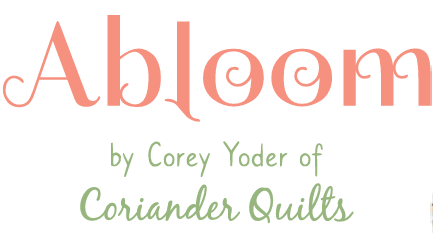Sunday Best Quilts Sampler Block 9 {Pineapple Block Tutorial}

Sunday Best Sampler Quilt
Welcome to week 9 of the Sunday Best Quilt Sampler sew along. This week, we will be working on Sherri’s Pier 44 sampler quilt block, a pineapple block.

Pier 44 Sampler block
I’ve heard some of you mention in my group on Facebook that you were a little bit nervous about the block this week. So Sherri and I are providing a lot of information this week to take away the nervousness about piecing a pineapple block. They really are fun, once you know how to go about piecing them!
I am sharing a tutorial for paper piecing these blocks below and Sherri will be providing information about using the Creative Grids Pineapple Trim ruler. Be sure to visit her site if you are using the ruler!

Paper pieced pineapple block
I realized as I started planning this blog post for today that I paper piece a little bit differently than the tutorials I was going to link to. So, I decided to type up how I paper piece to share with you all.
You will need the following supplies: Sunday Best Quilts Book, the Pineapple foundation pattern on pages 68 & 69 (you will need a total of 4 copies to make the sampler block (I used regular copy paper)–join the halves with a glue stick. You can see my prepared foundation paper in the picture below. I like to leave about 1/4″ outside of the seam allowance to trim later), rotary cutter, ruler, glue stick, stiletto or seam ripper (I use the stiletto end of the C&T 4-in-1 tool often for paper piecing–but you can also just use a seam ripper), fabrics cut according to page 65. We will be making 4 Pineapple blocks for our sampler block.

Gather your supplies
- Begin by centering the square piece of fabric on the wrong side of of the foundation paper. Use the glue stick to hold the fabric in place. Alternatively you can pin this in place.

Center square on wrong side of foundation paper.
2. Hold paper up to the light so you can make sure that you have 1/4″ of fabric overhanging the entire perimeter of the center square.

Center fabric should overhang 1/4″ around the perimeter of the center square.
3. Next, place the foundation paper with the lines facing up and the fabric side facing down. Using a stiletto, score the line between piece 1 and 2 across the width of the paper.

Score the line between piece 1 & 2 across the width of the paper.
I have marked where I scored so you can see.

Gently score.
4. Fold back the foundation paper along the scored line.

Fold back the foundation paper along the scored line.
5. Trim 1/4″ away from the folded edge of the paper.

Trim 1/4″ away from the folded edge of the paper.
It will just be a little bit of fabric you are trimming away.

Trimming
6. Fold the paper back down so there is no longer a fold in the foundation paper. Place the foundation paper with the fabric facing up. We are now ready to sew Piece 2 to our center square. Align the Piece 2 white rectangle with the edge of the trimmed square, right sides together. Center the white rectangle.

Align and center piece two with the center square.
Adjust the stitch length on your machine to a shorter stitch. I set mine at about 1.5. You want it short enough that it nicely perforates the paper but not so short that it causes the paper to tear away as you sew.
7. With the fabric side down, sew along the line between pieces 1 & 2. You will stop and start approximately 1/4″ above and below the line. I have marked where to sew in red in the picture below. There is no need to back stitch. After sewing, press away from the center–do not use steam. Steam can cause your paper to shrink which will result in a block that is too small.

Stitch along the marked line.
Repeat steps 3-7 to add piece 3. You will be working with the line between piece 1 & 3. Your block will look like this after adding on pieces 2 & 3.

This is what the block looks like after pieces 2 & 3 have been sewn on.
You will now repeat the steps using the line between pieces 1 & 4. You will be sewing Piece 4 on which is still the white background.

When trimming this section, you will need to gently fold the paper back from the stitches. The stitches should stay in the fabric but pull away from the paper.
Unfold, align and center piece 4. Sew into place just as you have been doing.

Align and center piece 4.
This is what the unit looks like after piece 4 has been sewn into place and pressed.

Repeat on the line between pieces 1 & 5 to complete the first round by adding Piece 5. We are now ready to move on to the second round. For each round, you will be adding 4 pieces of fabric.

Score the line between pieces 2/4 & 6. In this photo, you can also see how my stitching extends into the adjacent seam allowance.
Trim a 1/4″ seam allowance past the fold of the paper.

Trim a 1/4″ seam allowance past the folded paper.
Trim.

You can see the fabric that I have trimmed away.
Unfold the paper, flip the fabric side up, align and center piece 6. Sew into place. You will always sew 1/4″ before and after the marked line.

Unfold the paper, flip the fabric side up, align and center piece #6
Sew piece 6 into place and press. This is what the block now looks like.

Piece 6 added.
Repeat to add piece 7. You will be working with the line between piece 3/5 and piece 7.

Piece 7 sewn on.
Follow the same steps to score and trim and then add piece 8. When adding piece 8, you are working on the line between pieces 2/5 and piece 8.

In the same manner add piece 8.
This is what your block looks like after pieces 8 & 9 have been added.

Block after pieces 8 & 9 have been added.
And here is what the foundation paper side looks like at this point.

Add pieces 10 & 11.

Align, center, and sew pieces 10 & 11. You can score and trim both sides at the same time. And then sew them.
And here is the block once these two sides have been pressed.

And the block after pieces 12 & 13 have been added.

You have now added the first 3 rounds to your pineapple block. You will continue adding rounds until you have all of the rounds added.
Here is your block after you have added rounds 14-17:

And after rounds 18-21:

And after rounds 22-25:

And the last rounds 26-29:

You just keep repeating the steps over and over until you have finished the block. Now, we are ready to trim the block.

Back before trimming.
We will line up our ruler and trim away the dashed perimeter of the foundation paper.

Trim the block on the outside dashed line.
Block after trimming is complete:

And now, you can remove the paper backing. It should come off pretty easily along the sewn lines.

Completed Block
I know we all learn and understand things differently so I hope this helps some of you out. There are also other tutorials on paper pieced pineapple blocks both on Youtube as well as by googling. They are going to be slightly different techniques which is great so you can find a way that works awesome for you. If you haven’t paper pieced before, it might feel a little bit backwards. =) And remember to check out Sherri’s video tutorial for using the Pineapple Trim Ruler by visiting her site.
Here are the rest of the instructions for the Pier 44 Sampler block.
And the Pier 44 coloring page.

We love seeing your blocks so be sure to use #sundaybestquiltssampler on Instagram and tag us so we can see! @corianderquilts and @aquiltinglife
Happy Sewing!





























I have made a couple quilts using the paper piecing technique. This is one of the BEST visual step-by-step tutorials I have ever seen! Thank you Corey for such a useful tool.